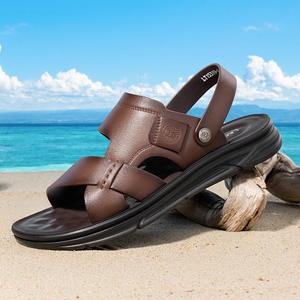
Requirements and methods for checking leather sandals and factory inspection services
As an important footwear product in summer, the quality of leather sandals directly affects the wearing comfort and usage safety. To ensure that leather sandals meet the national industry standards and quality certification requirements, establishing a professional inspection process is of vital importance. This article will systematically introduce the inspection standards, testing methods and certification requirements for leather sandals, providing a complete quality control guideline for enterprises.
I. Product Classification Certification System
1.1 Classification Certification for Wearer Groups
Standard for Inspection and Certification of Men's Leather Sandals
Standard for Inspection and Certification of Women's Leather Sandals
Special Safety Certification for Children's Leather Sandals
1.2 Style Classification Certification
Inspection Certification for Strap-Type Leather Sandals Structure
Full-coverage leather sandals integrity inspection and certification
Hollow-style leather sandals quality certification
Inspection of Safety Performance of Front-Sole Leather Sandals
Post-empty style leather sandals stability test certification
Other style specific inspection standards
1.3 Classification and Certification of Lining Materials
Quality Inspection Certification for Natural Leather Lining
Certification of Performance of Synthetic Leather and Artificial Leather Outer Sides
Test of the durability of textile upper surfaces
Evaluation of material compatibility for mixed-material products
1.4 Classification and Certification of Manufacturing Processes
Certification of Bonding Process Strength Inspection
Inspection standards for the precision of sewing techniques
Molding process integrity certification
Ductility test of the sulfurization process
Quality inspection standards for injection molding process
Uniformity certification of the infusion process
II. Sensory Quality Inspection and Certification Standards
2.1 Main Project Certification
Zero-tolerance Inspection Standard for Severe Defect Items
Key quality indicators and professional certification
Safety hazard control system with strict management measures
2.2 Secondary Project Certification
Appearance Defect Grading Inspection Standards
Quality certification of process details
Professional assessment of aesthetics
III. Physical and Mechanical Performance Inspection Certification
3.1 Abrasion Resistance Certification
Standard for 40,000 Times Flexibility Test
Standardized inspection process for pre-cutting openings
Special circumstances exemption from certification standards
3.2 Abrasion Resistance Certification
Professional Inspection Certification for Outsole Abrasion Resistance
4.9N Pressure Standardization Test
Strict control over the phenomenon of insufficient sulfur content
3.3 Detachment Strength Certification
Test Standards for Bonding Strength between the Base and the Bottom
Special circumstances require a modified certification process
Strength indicator grading inspection requirements
3.4 Lacing Pull Strength Certification
Special Inspection Standard for Frontless Sandals
Standardized sample preparation process
Professional certification for tensile testing
3.5 Shoe heel hardness certification
Formed sole hardness inspection standard
Special testing and certification of foaming materials
Hardness index grading assessment
3.6 Adhesion Strength Certification
Test for the bonding strength between the outsole and the midsole
Special Certification Standards for Micro-Hole Bottom Conditions
Minimum inspection requirements
3.7 Shoe heel bonding strength certification
Special inspection for prefabricated shoe heels
Combination force standardization test certification
Special circumstances exemption from testing criteria
3.8 Crucible Performance Certification
Steel Crucible Rigidity Inspection Test
Professional certification for hardness indicators
Special process exemption testing standard
3.9 Certification of Fiberboard Flexural Index
Testing standard for flexural performance inspection
Compliance Certification of Index Indicators
Professional assessment of material durability
3.10 Color Fastness Certification
Fabric Resistance to Abrasion Test
Professional certification for color fastness of inner padding
Standardized assessment of color沾age levels
3.11 Footwear Anti-abrasion Certification
Assembly-type Footwear Surface Inspection Standards
Professional testing of wear resistance performance
Service life assessment certification
3.12 Limited Substance Certification
Hazardous Dye Inspection and Testing Standards
Chemical Safety Professional Certification
Verification of compliance with environmental protection requirements
IV. Test Methods and Inspection Certification System
4.1 Odor Detection Certification
Standardized inspection process for dryers
Professional Judging Personnel Qualification Certification
Odor grade classification assessment criteria
4.2 Performance Testing Certification
Standardization of Abrasion Resistance Testing
Professional certification process for wear resistance performance
Standardized test method for peel strength
4.3 Special Testing Certification
Help to establish the strength inspection standards for the pull-out test
Professional testing method for shoe heel hardness
Standardized testing procedure for bonding strength
4.4 Safety Performance Certification
Test standard for shoe heel adhesion
Professional certification method for the locking mechanism
Standardized test for the flexural index of fiberboard
V. Inspection and Certification Process Standards
5.1 Sampling Inspection Plan
Implement statistical sampling certification in accordance with industry standards
Safety-critical projects implement a full inspection certification system.
Establish a complete quality traceability management system
5.2 Inspection Environment Requirements
Standardize the configuration of the inspection laboratory environment
Regular calibration and certification of professional testing equipment
Standardized management of test conditions
5.3 Defect Level Determination
Serious Defect: Zero tolerance for issues that affect wearing safety
Main defect: Obvious quality issues are strictly controlled.
Minor defect: The appearance flaws fall within the acceptable range as per the standards.
VI. Key Control Matters for Factory Inspection Certification
To ensure that the quality of leather sandals continuously meets the certification requirements, during the factory inspection process, the following matters need to be given special attention:
Raw material control certification: Establish a quality assessment system for leather and accessory suppliers
Production process control: Develop operation standards for key processes such as cutting, sewing, and shaping.
Calibration of testing equipment: Regularly calibrate all measuring instruments and equipment
Chemical safety management: Establish a detection and certification system for hazardous substances
Personnel qualification certification: Professional training and certification for inspection personnel for on-the-job requirements
Inspection and Certification Summary
The inspection and certification of leather sandals is a comprehensive process that involves a thorough examination of the material quality, manufacturing techniques, and performance. By establishing a professional inspection process and strict quality standards, enterprises can ensure that leather sandals meet industry certification requirements, providing consumers with comfortable, safe, and fashionable summer footwear products.
分享这个商品

Requirements and methods for checking leather sandals and factory insp
As an important type of footwear in summer, the quality of leather sandals directly affects the wearing comfort and safety during use.
